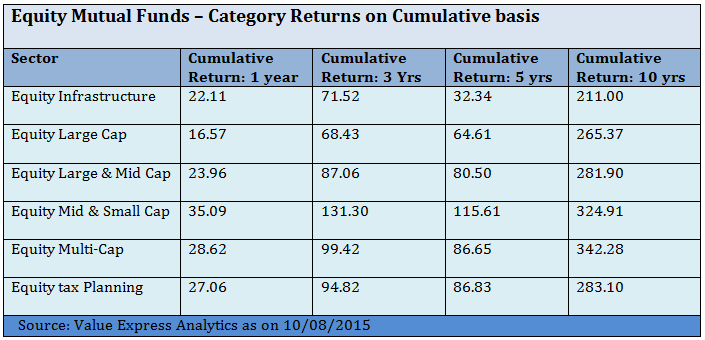Mutual Fund Investment Choices based on various factors

Investment choices are fundamental to your goals. The choices you make determine where your hard earned money has to be invested. The results are reaped after a period of time; when the investment has procured the desired returns. When you hear the term investment choices you are bound to think Mutual Funds, Debt investments, Gold Property, Fixed income instruments are the various choices you have. You are correct in thinking these are the choices you have. However, it maybe erroneous to think that these are the only choices you have. The fundamental choice you are making when you are picking an investment instrument is assessing your investing needs and matching the same with your investment appetite. An investor who wishes to be personally involved in the process of investing will be in tune with his investing needs and the extent to which he is willing to take risks to reach the investing goals. To understand the investment choices we first need to understand the investment appetites. In this article we will broadly cover the choices but shall focus on Choices that you can make in Mutual Funds investments.
Investment Appetite
When you are ordering pizza online you are presented with an array of choices between vegetarian and non vegetarian main course, the side dish, the beverages you want and finally the total amount is presented. You change any one of the components in your selection the ultimate amount is affected. Creating a portfolio based on your investment appetite is a similar process. As an investor you have to understand the extent of risk you are willing to take and an assessment of how will you deal with bad losses, if there is any. A realistic assessment of returns your portfolio could possibly generate and whether it is in sync with your expectations. At last liquidity, where you decide for how long you are willing to lock away your money and whether it will be a beneficial move for your ultimate goals. An eclectic mix of these three elements constitutes your investment appetite. The decisions you make on the basis of these aspects ultimately determine your portfolio returns. Even if you change one aspect of any of these investments the ultimate return is altered. Is it not like ordering pizza online?
Risk: How Far It Takes You
Risk predominantly has a negative connotation. Investors have a tendency to avoid products which have the tag of being risky. Risk is associated with loss. Hence, a risky product is the one where you stand to lose much more than you gain. These are the usual views of risk, one of loss and avoidance. So after such a negative picture has been painted the question is how much risk should an investor take?
Risk could also be viewed in a different light where risk is inseparable from performance. In some cases taking a risk is necessary to gain the returns. The extent of risk as an investor you are willing to take depends on your financial status and psychological comfort with the prospect of uncertainty and incurring short term losses for long term gains. The risk is often measured in relative terms through benchmarks. The riskier an investment scheme is supposed to be, it is also expected to surpass the category benchmark substantially. The historical returns of a risky scheme are where the investor draws comfort from while investing in present. Through the investing world one aspect is always emphasized on calculated risk in the present always pays off in the future. However, to be able to take such risks one has to overlook minor short term losses or volatility in the market. Risk could be as less as zero like the fixed income instruments such as fixed deposits and Public Provident Funds where there is guaranteed returns at negligible risk. However, the downfall occurs in terms of inflation adjusted returns. The returns are not enough to outdo the inflation or the rate of return is equal to that of the rate of rising inflation. Equity investing is associated with a moderate to very high degree risk. However, they provide inflation adjusted returns. There could be short term losses but certain equity classes have generated long term returns which are far superior to other asset classes like, Gold, Property, Fixed income products etc. Let us see how equity Mutual funds in different categories have often generated returns beating the inflation.

As an investor while you are making various investment choices your personal risk appetite plays an important role in ascertaining the asset classes you invest in. The choice is not just about specific funds but also are you exposing your funds to enough risk to generate the returns because the higher the risk, the tendency to generate returns is higher as the investors also have to be compensated for being able to take a certain amount of risk.
Returns: How Much is Enough
Returns and risk is intertwined. It is often see the higher the risk an investor takes, they reap better returns. The question you need to ask while investing is, how much return is enough and depending on that you expose your portfolio to risk. Returns are also determined by time factor. The period of investment determines the compounding effect on a certain investment. So an investment of र 2000 per month for the next forty years invested through Systematic Investment Planning (SIP) is going to fetch you higher returns than र 30,000 per month invested for only five years. Returns are often not determined by the amount you invest. Rather, the time period for which you invest and instrument in which it is invested.
The returns that you expect your portfolio to generate should ideally be aligned to your financial goals and the time period of their fulfillment. The risk and returns and the time period all have to align for the fulfillment of a goal. For example, if you are aged 35 presently, you have a period of 25 years to invest for retirement. Since you have a long time period by your side you can take high risk as short term losses may turn into long term gains. However, if you are in need of a corpus in the next three to five years then you need to invest in an instrument which has historic records of generating substantiate returns within a time period of three to five years. Equity Linked Savings Scheme are a good example where a lock in period of three years exist and usually generates inflation adjusted returns within a period of three to five years.
Liquidity: Far Away or Close Enough
Liquidity is simply ascertaining how easily you wish to access your money without losing much of it in exit loads and payment of taxes. Certain investment instruments have strict norms about liquidity where the invested amount cannot be accessed for a fixed period of time. Usually fixed income instruments come with a fixed time period of investment. Public Provident Fund has a fixed investment period of fifteen years; National Pension Scheme has a fixed investment period till the investor turns 60 years. So while the fixed income instruments keep providing steady returns they are not liquid in nature. Hence, as investor you are sure you are setting aside investments for a certain purpose then fixed income instruments could be ideal. However, if you require quick returns and liquidity, liquid funds could be a good option where investors can invest for as less as even one month and keep generating returns instead of the money lying stagnant in bank accounts. Hence, investors also have to make the crucial choice of liquidity.
Conclusion
It is evident from what has already been said that risk, return and liquidity are perhaps more crucial choices to make than deciding the individual funds for investment. Investing choices are not just driven by a keen understanding of your needs and the risks you are willing to take in order to ensure their fulfillment. Before you start investing and make different choices do consult your financial advisors and check you risk taking appetite, decide your investment horizon and figure out the financial goals for which you are planning to invest.
RECOMMENDED READS
Follow Birla Sun Life MF
More About ABSL MF
POST A QUERY





